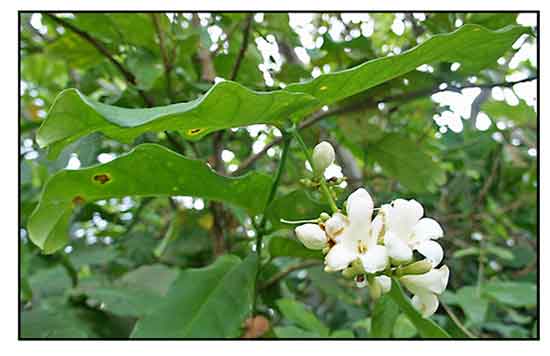
Family • Gentianaceae
Balat-buwaya
Kabal
Utania volubilis (Wall.) Sugumaran
FOREST COFFEE PLANT
| Scientific names | Common names |
| Fagraea volubilis Wall. | Balat buwaya (Tag.) |
| Utania volubilis (Wall.) Sugumaran | Kabal (Tag.) |
| Accepted infraspecifics (2) | Kuliba-o (Sorsogon) |
| Utania volubilis var. microcalyx (Wong & Sugau) W., S., & Sugau | Tarong-tarong (Tag.) |
| Fagraea cordifolia Blume | False coffee tree (Engl.) |
| Fagraea gracilis Cammerl. | Foreest coffee plant (Engl.) |
| Fagraea ligustrina Blume | |
| Fagraea volubilis var. microcalyx K.M.Wong & Sugau | |
| Utania volubilis var. volubilis | |
| Fagraea appendiculata Blume | |
| Fagraea coarctata Blume | |
| Fagraea grandifolia Merr. | |
| Fagraea latifolia Miq. | |
| Fagraea morindifolia (Reinw.) Blume | |
| Fagraea pauciflora (King & Gamble) Ridl. | |
| Fagraea racemosa var. pauciflora King & Gamble | |
| Fagraea rodatzii K.Schum. & Lauterb. | |
| Fagraea scholaris Blanco | |
| Fagraea subreticulata Blume | |
| Kentia morindifolia (Reinw.) Steud. | |
| Kuhlia morindifolia Reinw. | |
| Utania morindifolia (Reinw.) G.Don | |
| Utania volubilis is an accepted species. KEW: Plants of the World Online | |
| Note: There is a confusing sharing of scientific names and vernacular names by Utania racemosa and U. volubilis. A few compilations list them as synonyms, many more list them as separate species. Kabal and 'False coffee tree' as common names are applied to both. | |
| Note: Some compilations list Utania volubilis and Fagraea racemosa as synonyms; POWO lists them as separate species. POWO lsits Fagraea racemosa as a synonym of Utania racemosa. | |
| Link: Kabal | |
| Other vernacular names |
| GERMAN: Salakpalme. |
| INDONESIAN: Salak gantung. |
| MALAY: Salak, Todopon puok, Kopi hutan, Sepuleh. |
| SUOMI: Salaki. |
July 2024
![]()
 |
| PHOTOS / ILLUSTRATIONS |
| IMAGE SOURCE: Gentianaceae : Utania volubilis / Flowering twig / Copyright © 2013 by Alma P Gamil (contact: [email protected]) [ref. DOL75181] / Non-Commercial Use / Image modified / Click on image or link to go to source page / Phytoimages.siu.edu |
| OTHER IMAGE SOURCE: Gentianaceae : Utania volubilis / Kuliba-o / Inflorescence / Copyright © 2013 by Alma P Gamil (contact: [email protected]) [ref. DOL75195] / Non-Commercial Use / Image modified / Click on image or link to go to source page / Phytoimages.siu.edu |
| OTHER IMAGE SOURCE: Gentianaceae : Utania volubilis / Infructescence / Copyright © 2014 by Greg Rule (contact: [email protected]) [ref. DOL80520] / Non-Commercial Use / Image modified / Click on image or link to go to source page / Phytoimages.siu.edu |
Additional
Sources and Suggested Readings |
• |
DOI: It is not uncommon for links on studies/sources to change. Copying and pasting the information on the search window or using the DOI (if available) will often redirect to the new link page. (Citing and Using a (DOI) Digital Object Identifier) |
PHOTOS / ILLUSTRATIONS |
| List of Understudied Philippine Medicinal Plants |
| New plant names needed The compilation now numbers over 1,300 medicinal plants. While I believe there are hundreds more that can be added to the collection, they are becoming more difficult to find. If you have a plant to suggest for inclusion, native or introduced, please email the info: scientific name (most helpful), local plant name (if known), any known folkloric medicinal use, and, if possible, a photo. Your help will be greatly appreciated. |
• |
 |


 Botany
Botany